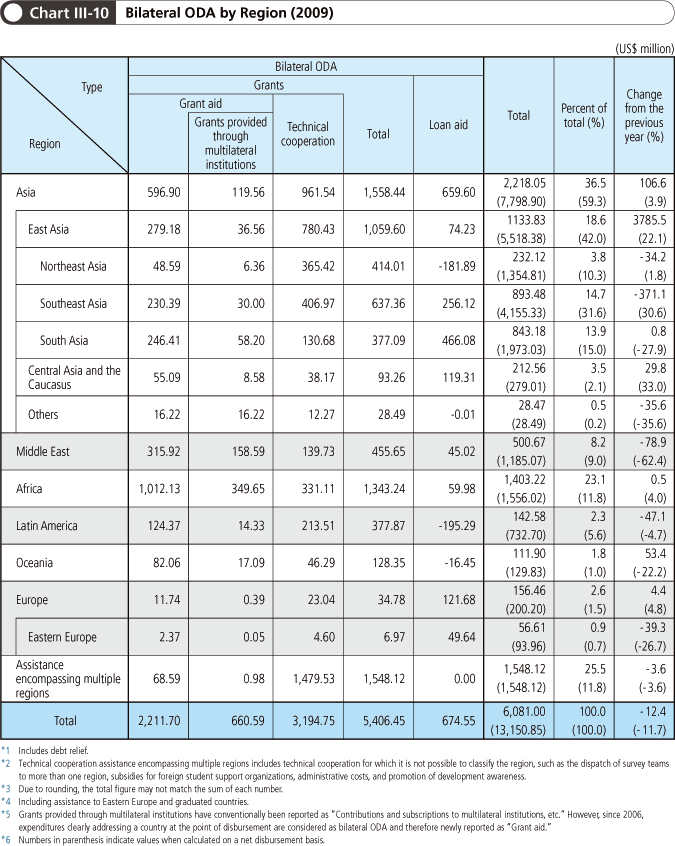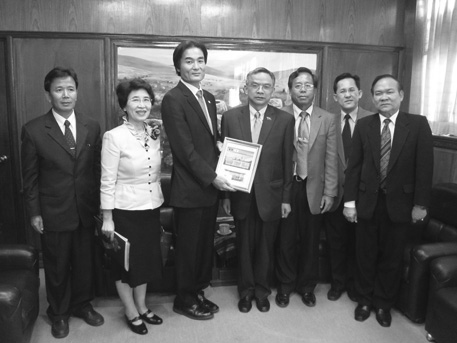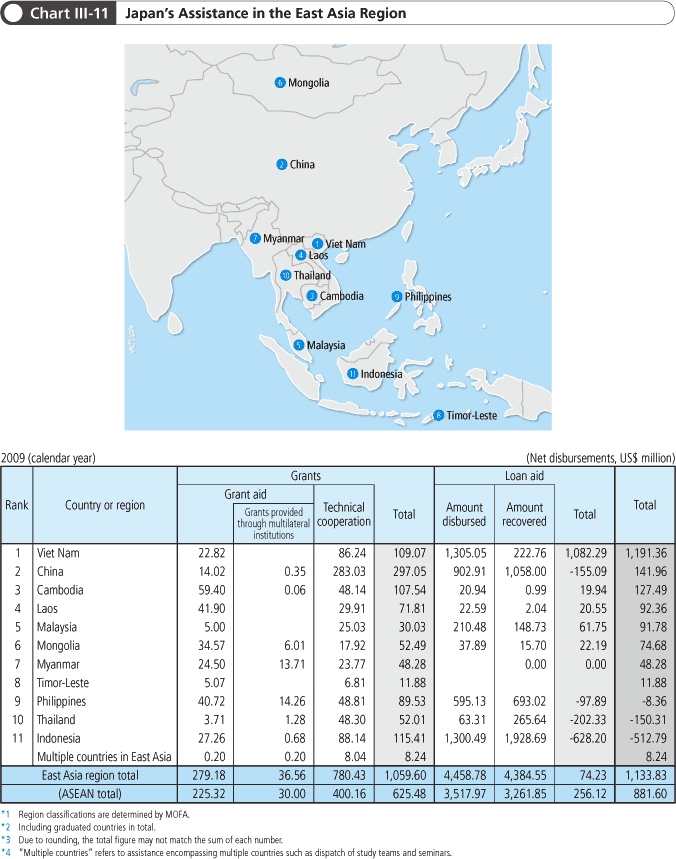Japan's Official Development Assistance White Paper 2010
Section 3 Assistance for Each Region
The challenges and problems vary according to the countries and regions. Japan works to resolve the problems faced by developing countries through ODA, taking into consideration the structures behind these problems.

1.East Asia
East Asia consists of a variety of nations: countries such as the Republic of Korea (ROK) and Singapore, which have attained rapid economic growth and have already been shifted from aid recipients to donors; least developed countries (LDCs), such as Cambodia and Laos; countries such as China, which still has internal disparities despite its dramatic economic growth in recent years; and countries such as Viet Nam, which is in the process of transitioning from a centrally-planned economy to a market economy. Japan has close relationships with these countries in all aspects, including political, economic, and cultural dimensions. The development and stability of this region have great significance for the peace and prosperity of Japan. Under this philosophy, Japan engages in assistance activities, fully taking into account such diversity in socio-economic conditions and changes in the respective assistance needs of East Asian countries.

Parliamentary Vice-Minister for Foreign Affairs Hisashi Tokunaga receiving a framed Laotian bank note and stamp designed by a Japanese ODA project, after his meeting with Minister of Public Works and Transport Sommath Pholsena of Laos (third from left)
<Japan’s Efforts>
Japan has contributed to the remarkable economic growth in East Asia by combining ODA with trade and investments to provide infrastructure development and assistance for institutional and human resource development, to promote trade, and to vitalize private investments. Currently, Japan aims to further enhance open regional cooperation and integration based on shared basic values while also ensuring regional stability by promoting mutual understanding. For that reason, Japan has made efforts to respond to transnational problems such as natural disasters, environment and climate change, infectious diseases, and terrorism and piracy. In addition, Japan also works for the promotion of mutual understanding through large-scale youth exchanges, cultural exchanges, as well as projects that disseminate Japanese language education and promotion of Japan.
The impact from the global financial and economic crisis that started in 2008 has largely been overcome. But in order for Japan and Asian countries to achieve further economic prosperity it will be important to turn Asia into a center of growth open to the world. Japan thus provides assistance to reinforce Asia’s growth and to expand domestic demand in Asia. As a specific measure, in April 2009 Japan announced that it would provide a maximum of ¥2 trillion in ODA. Under this initiative, Japan provides steady assistance for such efforts as infrastructure development, support for the socially vulnerable, the establishment of low-carbon societies, and human resource development.
● Support for Southeast Asia
The ASEAN countries have set intraregional integration as their chief goal by the year 2015. In line with this goal, Japan provides support to strengthening connectivity and reducing disparities within the region. Supporting the Mekong countries, many of which were late-joining members to ASEAN, in particular is important for reducing intraregional disparities. In November 2009, the First Mekong-Japan Summit Meeting between the heads of Japan and the Mekong region countries was held. They shared the recognition of giving priority to the following areas and of establishing A New Partnership for the Common Flourishing Future: 1) Comprehensive Development in the Mekong Region, 2) Environment, Climate Change (”A Decade toward the Green Mekong” Initiative), and Overcoming Vulnerability, and 3) Expansion of Cooperation and Exchanges. Japan continues the policy to expand its ODA to CLV countries respectively as well as to the Mekong region as a whole. Japan committed more than ¥500 billion of ODA in the next three years for the Mekong region to promote this initiative. Also, Japan announced the concept for the Decade Toward a Green Mekong at the Third Mekong-Japan Foreign Ministers’ Meeting held in July 2010. In October 2010, the Second Mekong-Japan Summit Meeting between the heads of Japan and the Mekong region countries was held, and the Action Plan for ”A Decade toward the Green Mekong” Initiative and the ”Mekong-Japan Economic and Industrial Cooperation Initiative (MJ-CI) Action Plan” were adopted.
Additionally, economic partnership agreements (EPA) between Japan and Indonesia, Brunei, the Philippines, and ASEAN as a whole went into effect in 2008. An agreement between Japan and Viet Nam also entered into force in October 2009. With these EPAs, Japan has been working to expand trade and investments and enhance wide-ranging economic relations that include the improvement of distribution systems and the harmonization of economic systems such as intellectual property systems and competition policies. Through these efforts, Japan works to reduce poverty, and supports regional integration by rectifying disparity within the ASEAN region. ASEAN adopted ”ASEAN Plan for Connectivity” at its summit in October 2010 in order to enhance intra-ASEAN connectivity in fields such as infrastructure, institutions, and personal exchanges. Japan supports further elaboration of this master plan through ODA and joint initiatives between the public and private sectors. What is more, Japan also engages in peacebuilding activities, including concentrated support for the former conflict region of Mindanao in the Philippines and nation building support for Timor-Leste.
Japan reinforces its collaboration with the Asian Development Bank (ADB), which works on a range of regional cooperation initiatives in the Asian region. For instance, in order to support Asian developing countries, Japan has established the Accelerated Co-Financing scheme with ADB (ACFA) which enhances cooperation between ADB and the new JICA, the Investment Climate Financing Fund (ICFF), and the Asian Clean Energy Fund (ACEF), under the Enhanced Sustainable Development for Asia (ESDA) initiative to promote investment and energy efficiency in the region. In addition, Japan collaborates with the Economic Research Institute for ASEAN and East Asia (ERIA), an international research organization in East Asia, with varying levels of cooperation such as the Comprehensive Asian Development Plan (CADP) and the Master Plan on ASEAN Connectivity.
Furthermore, on the financial front in particular Japan is leading the Chiang Mai Initiative (CMI) through the ASEAN+3 framework. This initiative is designed to prevent a chain reaction of crises and its expansion by means of providing short-term foreign currency financing for countries in which critical circumstances have arisen, such as obstacles arising in their foreign currency payments due to precipitous outflows of capital. What is more, in March 2010 a Multilateralization Agreement was issued which changed the former CMI framework, which was based on agreements between bilateral authorities, to a framework based on a single agreement for expediting and facilitating assistance. This enabled faster responses to the international balance of payments within the ASEAN+3 region as well as to the difficulties with liquidity in short-term financing, and thereby strengthened capacity for dealing with the risks and challenges of an expanding global economy.
In conjunction with the CMI, Japan leads initiatives to foster an East Asian bond market. In particular, in May 2010 the decision was made to establish the Credit Guarantee and Investment Facility (CGIF) in order to ensure bonds issued by Asian companies that are denominated in local currencies. This will serve as an ADB trust fund with initial capital on the order of US$700 million. Japan has contributed US$200 million through JBIC.
● Relations with China
Since 1979, Japan’s assistance to China has helped the infrastructure development in coastal areas, environmental measures, improvement in the basic human needs sectors including health and medical care, and human resource development, and has contributed to the steady development of the Chinese economy. Also, Japan’s assistance has played a significant role in promoting and sustaining China’s reform and opening policy. Most of the assistance was provided in the form of loan aid. The assistance can be evaluated as having supported the development of economic relations between Japan and China as well as having functioned as one of the main pillars for the multilayered Japan-China relationship. Regarding this point, the representatives of China, including at the summit-level, have expressed their gratitude on many occasions. In light of China’s recent remarkable economic growth, Japan and China recognized that Japan’s ODA loans for China would come to a harmonious end by the 2008 Beijing Olympics. Therefore, the new provision of loan aid was halted with the six Exchanges of Notes in December 2007.
Yet, the people of Japan and China face many common challenges to tackle, including global issues such as environmental problems and infectious diseases that may affect Japan directly. During President Hu Jintao’s official visit to Japan in May 2008, in a ”Joint Statement between the Government of Japan and the Government of the People’s Republic of China regarding the Comprehensive Promotion of a Mutually Beneficial Relationship Based on Common Strategic Interests”, the leaders of both countries confirmed that cooperation will be undertaken mainly in the areas of energy and the environment, while a joint declaration was issued relating to climate change. Moreover, increasing the mutual understanding between the people of Japan and China is an important issue from the perspective of facilitating the sound development of Japan – China relations. In light of this situation, grant aid is currently being implemented with its focus narrowed on: (1) areas conducive to resolving common challenges faced by the people of Japan and China such as the environment and infectious diseases, and (2) areas conducive to promoting mutual understanding and increasing exchanges between Japan and China. Also, in terms of technical cooperation, Japan is particularly focusing on projects aiming for the transition to a market economy, observance of international rules, promotion of good governance, and energy conservation. Exchanges of people can serve as an important means for transmitting Japanese values and culture to China. Based on the conditions surrounding bilateral relations, the cooperation will be conducted with appropriate deliberation from a comprehensive and strategic viewpoint.

●Indonesia: Lumut Balai Geothermal Power Plant Project
When greenhouse gas emissions from sources like the decrease of forests and the destruction of peat lands are added in, as of 2005 Indonesia had become the world’s fourth largest emitter of greenhouse gases after China, the United States, and Brazil (Note 31). Owing to factors like the increase in energy demand accompanying economic growth, consumption of coal has risen and emissions of greenhouse gases from the energy sector are growing larger. For this reason, there is a pressing need to give shape to climate change countermeasures such as the development of renewable energy with a view toward the reduction of greenhouse gases.
In the aim of improving the stability of the electricity supply on the island of Sumatra, Indonesia, Japan promotes the construction of the Lumut Balai Geothermal Power Plant through an ODA loan of approximately ¥27 billion. The objectives are to improve civil life, for the sake of economic development through improvements in the investment climate, and to reduce the burden on the global environment by promoting the development of renewable energy. As a direct outcome from the implementation of this project, it is forecasted that reductions in the emissions of carbon dioxide will reach 590,385 tons per year two years after the completion of the project. As such, the expectation is that it will improve the stability of the electricity supply in Indonesia and cut down greenhouse gases.
